As a born and bred Victorian, when I think “car ferry” I picture the big vessels used on the Queenscliff – Sorrento run across Port Phillip Heads, not the dinky little punts used to cross rivers. A less polite person might say cable ferries are something NSW uses because they are too dumb to build a bridge. However, Victoria does have one such ferry: crossing the 152 metre wide McMillan Strait between Paynesville and Raymond Island in the Gippsland Lakes.
The ferry service to Raymond Island commenced in 1889, using a punt previously used at Bairnsdale to cross the river prior to the construction of the Mitchell River Bridge. In 1903 a larger punt was commissioned, with improvements made in the 1920s, but manpower was still needed to pull the ferry until 1956. A modern ferry took over on the service in 1969 – since retired from the run, it was refurbished and has been used as a floating restaurant in Lakes Entrance since 2003.
The current ferry entered service in January 1997, having been built by Crib Point Engineering at Hastings between March and December 1996 at a cost of $900,000. The level of service provided by the Raymond Island Ferry is intensive – it operates for over 15 hours each day, with an average of 125 trips made across the straight in that time.
The path across the water is surprising short when looked at from the air.
The method of propulsion is very simple – a pair of submerged chains cross the water, running along the sea bed except where they pass through the ferry via guide wheels and drums, one either side of the vessel. The ferry is pulled against the chains by the two gypsy wheels, toothed drums which engage with the chain, being spun by hydraulic drive motors, powered by the onboard 2100HP diesel engine.
Cars drive straight onto and off the ferry, with folding ramps located at each end of the vessel, with the two ferry slips being simple concrete walls located beside the water. The journey takes around 5 minutes one way, including the time taken to align the ferry with the slip.
The vessel is 34.94 metres long, 10 metres wide: this allows 21 cars to be carried across three traffic lanes, as well as 50 passengers in the enclosed saloon. Car drivers and passengers stay inside their vehicle during the short trip.
Driving the ferry appears to be pretty simple: during the crossing both chains are used for haulage, on reaching the far end the rate of movement is slowed until the ferry makes contact with one of the fenders, with the remaining cable used to pull the ferry level with the berth to enable the car ramp to the lowered.
A control stand is located at both ends of the ferry, with the upper level walkway being restricted to the ferry operator. At deck level is the enclosed passenger saloon, and below deck is the engine room.
Unloading and loading the cars is a fast affair: the single ramp at each end is raised and lowered with hydraulic cylinder, and vehicle traffic is controlled by a set of traffic lights at either end.
Fare collection isn’t too involved, with gates or barriers are provided at the ferry slips – the queuing area at Paynesville is a simple line beside the road, on Raymond Island the queue forms along the main road because there is nowhere else to drive. There is also nothing stopping someone driving into the water if they are not looking where they are going!
Foot passengers and cyclists are carried free, while the majority of cars and trucks carried by the ferry hold season pass window stickers, which the ferry operator can inspect from the central walkway. Anyone without a pass can buy their ticket from the operator.
Further reading
- Ferry timetable
- Lots of facts and figures for the ferry
- Home page for the ferry – more about the construction of the current vessel, plenty of photos of the maintenance work to keep the service running, the history of the ferry service, and a whole lot more (the web design has a lot of “character”)
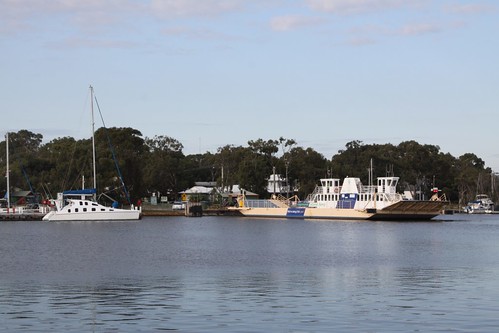
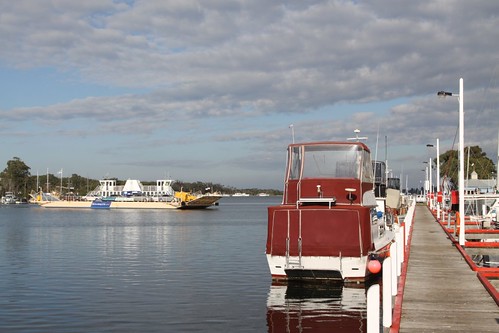

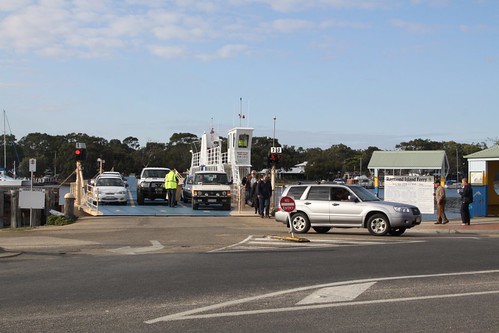

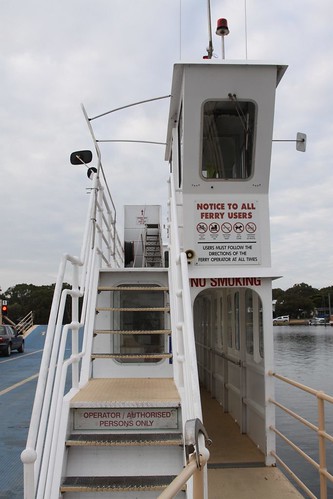
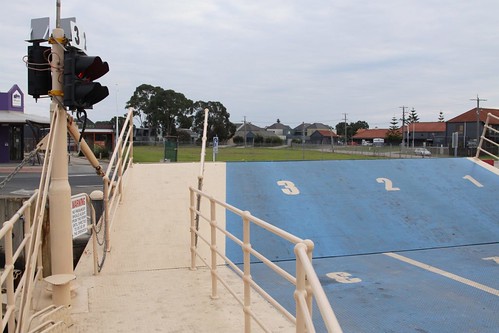
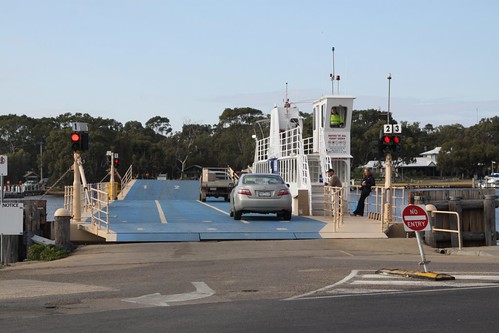

As for being too stupid to build bridges in NSW. May I point out several landmark bridges in NSW. Sydney Harbour bridge, Gladesville bridge, seacliff bridge, Anzac bridge, mooney mooney bridge, pheasants nest bridge, woronora bridge and the former suspension and now arch bridge called long gully bridge. So we do know how to build bridges of significant stature. What sort of bridges do you have in Melbourne. Besides the ones that don’t fall down.
According to the NSW Roads and Maritime Services department website, there are nine vehicular ferries in the state, all free:
http://www.rms.nsw.gov.au/roads/using-roads/trip-information/vehicular-ferries.html
The geography of Sydney is quite different to anywhere in Victoria, with Sydney Harbour in the middle and a mountain range surrounding the entire city. It is no surprise that the simplest way to get across the water is by boat, and when traffic gets heavier impressive bridges are needed.
Meanwhile down in Victoria the Gippsland Lakes would be the only waterway approaching the size of anything in NSW, and Victoria’s ‘number two’ bridge (the Bolte Bridge on CityLink) is just a cantilever span with two non-structural towers tacked onto the sides to make it look bigger.
just a small correction on the drive system of the raymond island ferry. It is powered by a 6cyl cummins turbo diesel rated at around 210hp, which drives 2 hydraulic pumps, which in turn power a 2 hydraulic motors that pull the chain through the ferry.
Thanks for the clarification!
[…] Raymond Island Ferry was another non-railway […]